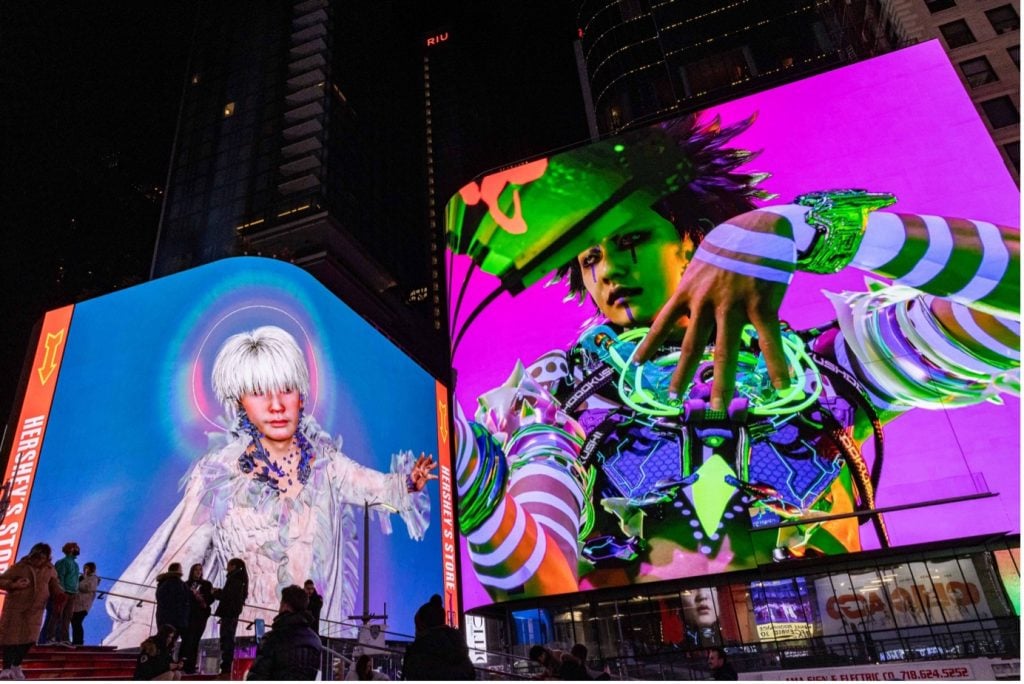What does 2024 hold for the world of art and technology? In the 1975 black comedy film A Boy and His Dog, 2024 is depicted as a time when humanity strives to survive underground after a nuclear war, possessing telepathic abilities to communicate with their dogs.
Luckily, as of now, humans are still living above ground. Less fortunately, we cannot speak to dogs (though the scientists are working on it.)
During a Twitter Space I hosted in 2023, artist Zach Blas reflected on the intertwining of technologies and systems of power, and their ideological underpinnings. His notion that technology, with its pervasive influence and fervor, can resemble a religion, seems particularly relevant today, when tech moguls Jeff Bezos and Elon Musk are enthusiastically building out “space habitats” and preparing to migrate civilization to outer space (in their own private shuttle services, of course), preaching faith in technology like modern-day messiahs.
As for the world of NFTs, once the subject of much futurist-infused excitement, the enthusiasm for PFPs (Profile Pictures) has dimmed, and many don’t even use the word “NFT” anymore. Instead, people talk about “digital art on-chain.” Obviously, last year wasn’t about setting price records. Sales have been generally on the wintry side, with a few exceptions. However, communities continue to flourish, and 2024 was quietly a year of experimentation and community-building for digital art enthusiasts. The art-centric Tezos ecosystem consistently has around 50 thousand monthly active wallets (cited from Kaloh), indicating a still-niche but passionate demographic.
For artists and collectors, the question remains: to be (on-chain) or not to be? Artists who avoid the term “NFT” want to steer clear of associations with scams and speculation, but also assert that the technology does not constitute an art genre. Meanwhile, for collectors, whether a work is on-chain or not can significantly impact both collection management and alignment with ideological beliefs: Some collectors exclusively acquire works on-chain, believing it is the natural format for digital art, while others do the opposite.
As an advocate for on-chain digital art myself, I see 2024 as presenting abundant opportunities for more candid discussions about blockchain technology, strategies for sustainable artistic ecosystems, and a future that is more inclusive.
In no particular order, and without any claim to being comprehensive, here are some digital-art highlights from the past year that will continue to shape our journey into 2024.
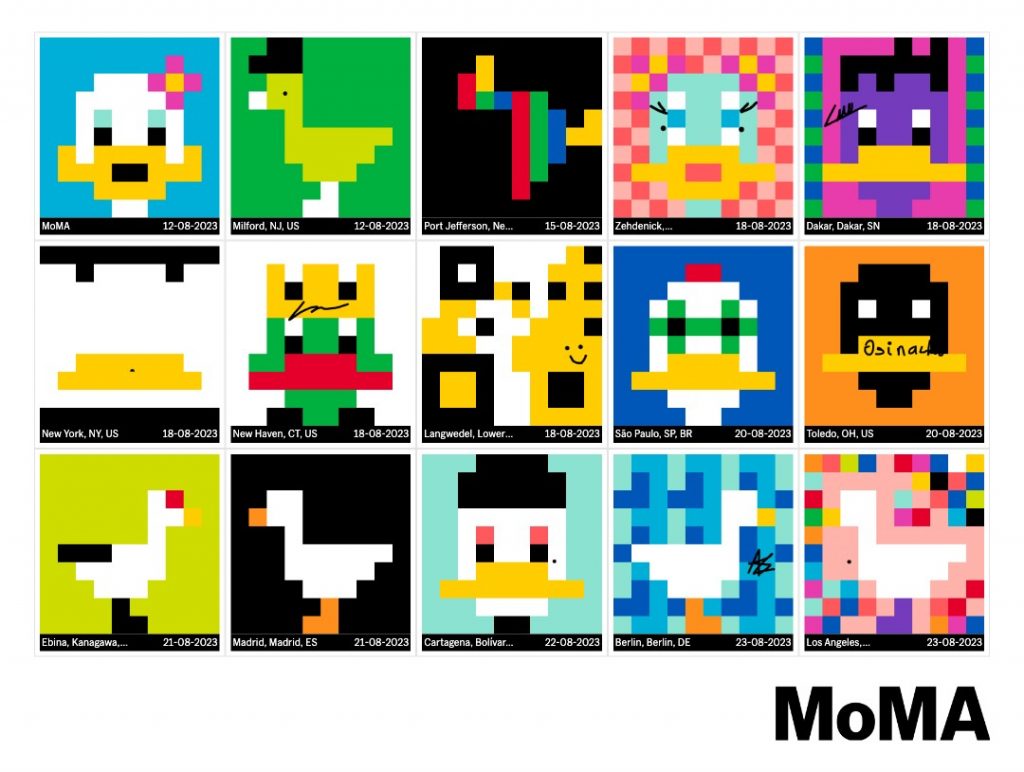
Dmitri Cherniak, Mango-Grayscale-Dada. Image courtesy MoMA.
-
- Refik Anadol’s generative artwork Unsupervised—Machine Hallucinations—MoMA, on view at the Museum of Modern Art last year, unsurprisingly joined the institution’s permanent collection. This addition is courtesy of a joint gift from digital art collector Ryan Zurrer, through his 1OF1 Collection, and the RFC Collection, led by Pablo Rodriguez-Fraile and Desiree Casoni. Nor was this the only blockchain project for MoMA in 2023: The “MoMA Postcard” initiative was launched in October, led by museum Web3 associate Madeleine Pierpont. This project is a nod to the Mail Art movement. Each blockchain-based postcard evolves collaboratively, accumulating stamps and contributions as it travels from one destination to another. No transactions are involved. Thus, “MoMA Postcard” represents an experiment in collective creativity on the blockchain, allowing everyone to create and explore blockchain technology. The first 15 artists invited by the museum to co-create digital “postcards” include: p1xelfool, ykxotkx, Grant Yun, Peter Burr, Anna Lucia, Sasha Stiles, Operator, Osinachi, IX Shells, Kim Asendorf, Sarah Friend, Linda Dounia Rebeiz, Casey Reas, LoVid, and Dmitri Cherniak.
- In February, the Los Angeles County Museum of Art (LACMA) revealed a substantial donation of blockchain-based artworks from NFT collector Cozomo de’ Medici. The donation includes 22 digital artworks by a cohort of 13 artists: Justin Aversano, Cai Guo-Qiang, Dmitri Cherniak, Claire Silver, Neil Strauss, Monica Rizzolli, Matt DesLauriers, Adam Swaab, Pindar Van Arman, plus a few including CryptoPunks and World of Women. This announcement coincided with LACMA’s “Coded: Art Enters the Computer Age, 1952–1982,” an exhibition showcasing the ascent of computer technology and the genesis of digital art.
- Also in February, the Centre Pompidou announced the acquisition of a series of 18 NFTs from 13 artists: Aaajiao, Emilie Brout and Maxime Marion, Claude Closky, Fred Forest, John Gerrard, Agnieszka Kurant, Jonas Lund, Larva Labs, Jill Magid, Sarah Meyohas, Robness, Rafael Rozendaal, and John F. Simon Jr. The acquisition—the first of its kind by a major French public museum—came as a result of a joint effort between scientific and administrative teams from the French Ministry of Culture and the Pompidou’s director, Xavier Rey.
-
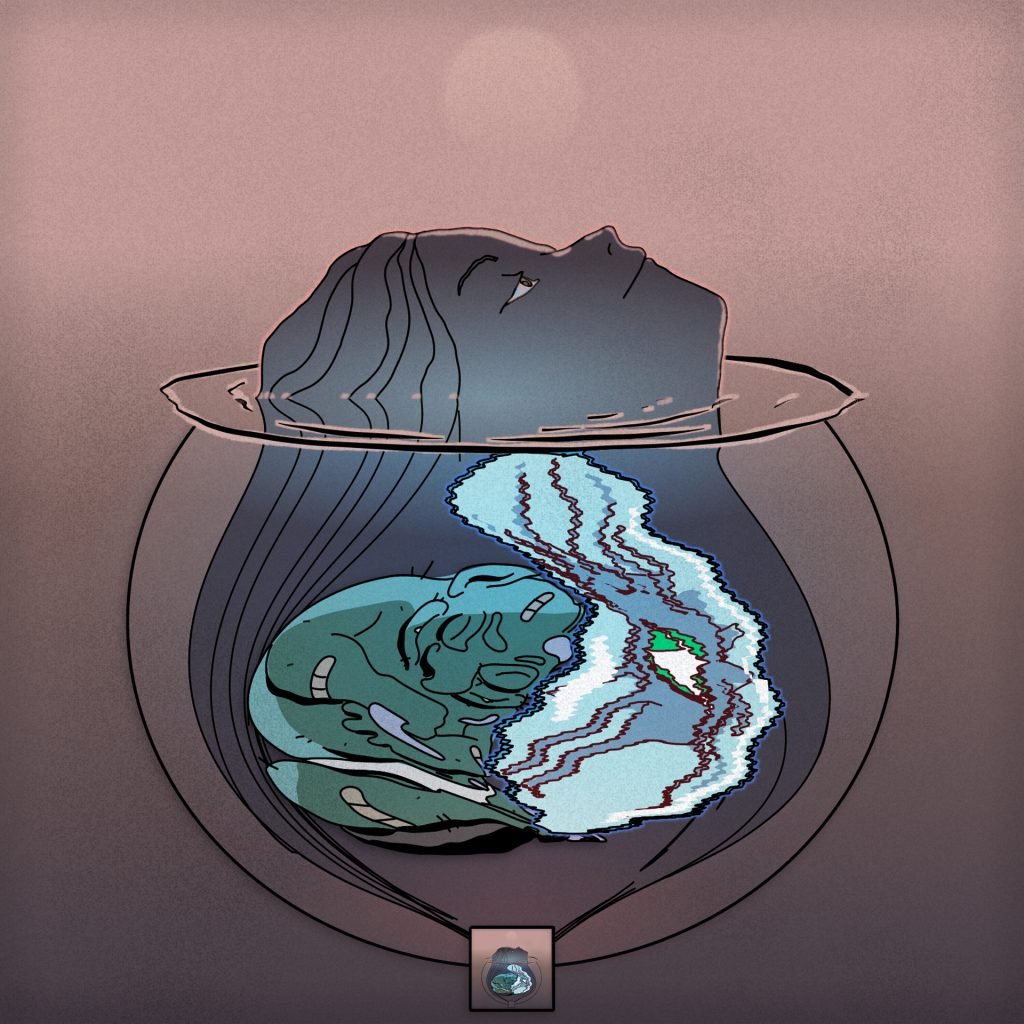
Ian Cheng, 3FACE, 2022. Courtesy of the artist.
- The Whitney Museum of American Art recently acquired Ian Cheng’s NFT creation, “3FACE,” produced by the inventive digital art publication Outland. Cheng’s piece stands as an adaptive artwork, marking a new addition to the museum’s collection. Notably, this isn’t the Whitney’s first foray into blockchain-based work (the first NFT was a gift of Eve Sussman’s 89 Seconds Atomized; the original piece from 2004 is in the Whitney collection already). Spearheading the acquisition is
Christiane Paul, the Digital Art Curator who oversees the digital art committee established in 2017.
- The art world bid farewell to Vera Molnár, a pioneering figure in computer-based and generative art, when she passed away in December 2023 at the age of 99. Molnár’s extensive exploration of mathematical principles and programming languages laid the foundation for contemporary algorithm-based digital art. In her final creative venture last year, she collaborated with generative artist and creative coder Martin Grasser to delve into the realm of NFTs. In July, their collection, “Themes and Variations,” achieved a remarkable feat, selling out instantly on Sotheby’s and accumulating a total sales volume of 631 Eth ($1.2 million).
- Lu Yang was a prolific presence this year, headlining no less than six solo exhibitions across prestigious venues like MUDEC Museum, Kunsthalle Basel, Nxt Museum in Amsterdam, and FACT Liverpool. Additionally, the artist debuted a series of NFT in collaboration with Vellum LA, Fabricatorz Foundation, and Feral File, including 88 editions that sold out on the opening night. His diverse body of work revolves around gender, biology, neuroscience, and religious themes, blending gaming tech and Japanese manga. Culminating the year, Lu Yang was invited by Times Square Arts’s Midnight Moment to take over Times Square’s 90-plus billboards with a post-human dance party featuring his elaborately outfitted and lifelike avatars, “DOKU.”
- Multimedia artist Nancy Baker Cahill embarked on several significant projects this year. Among them was her first solo museum exhibition in Georgia, alongside State Property, an animated neon AR depiction of a uterus exploding over the U.S. Supreme Court, a response to the ongoing reproductive rights crises in the U.S. Her recent project, CENTO, presented at the Whitney Museum, introduces a fictitious and futuristic bio-engineered interspecies entity. The monumental augmented reality “creature” hovers above the museum’s terrace, accompanied by a video that envisions the creature’s cave-like habitat.
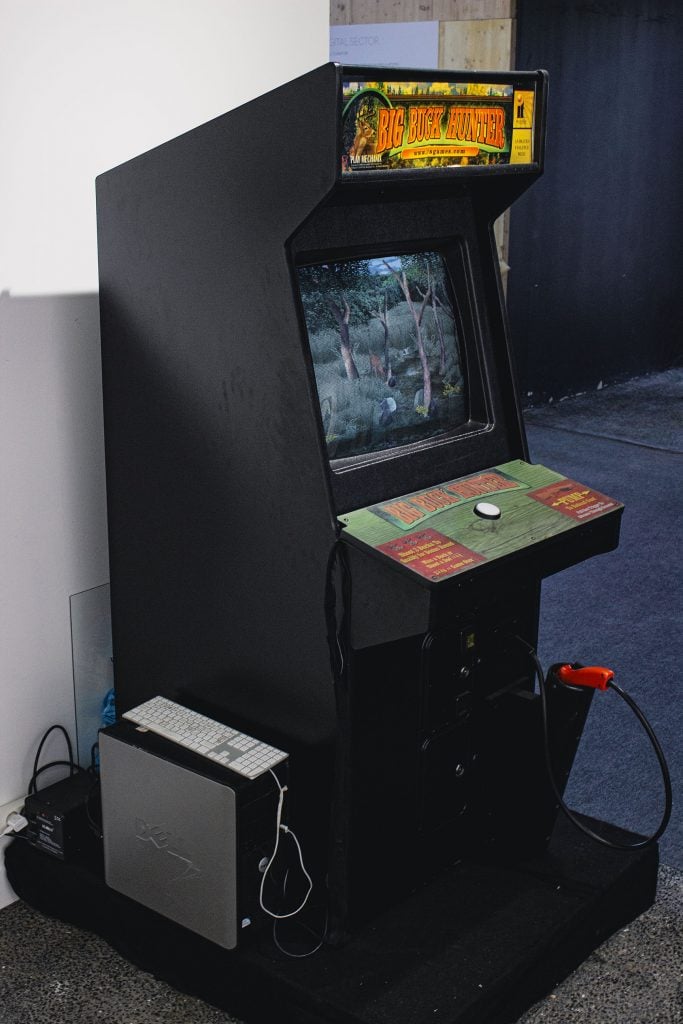
Robbie Barrat, Big Buck Hunter Restoration. Image courtesy L’Avant Galerie Vossen.
- Robbie Barrat‘s latest project, Big Buck Hunter Restoration, debuted at the Paris Photo Fair in November. For this endeavor, Barrat reverse-engineers and modifies a Big Buck Hunter cabinet (a deer hunting arcade game from 2000), creating a non-violent wildlife simulation that generates infinite landscapes. Despite being hailed by the digital art community as a legendary A.I. artist who achieved substantial financial success through exploring artificial intelligence, Barrat became disappointed with the speculative aspects of the market and has since ceased producing NFTs.
- A.A. Murakami, the London/Tokyo-based artist duo renowned for their nature-emulating sensory installations, premiered The Passage of Ra at NFT Paris in February in collaboration with Makersplace. It’s an immersive project presenting the artist’s vision of the “Mataverse.” Employing proprietary technology, they project both physical and digital fog rings into a dynamic seascape exhibited on screens, capturing the mesmerizing motion of swirling vortexes. The collection delves into the interplay of transience and endurance, juxtaposing a transient moment with the blockchain’s immutable nature. In May, A.A. Murakami created Metabolic Metropolis for Bright Moments Tokyo, where their signature fog rings continued their journey across the Tokyo cityscape in a game engine. Their latest generative artwork, Between Two Worlds, was presented with Verse Works. This new body of work draws inspiration from A.A. Murakami’s “Neon Sun and Fog Paintings,” creating an infinite range of luminous plasma lines suspended within vibrant color fields.
- Writer Alex Estorick and artist/poet Ana María Caballero released a digital collectible project called “artifacts” this year. Drawing inspiration from Byzantine tokens, which served not only as a form of currency but also as pilgrim tokens known as eulogíai (‘blessings’), stamped and gifted to pilgrims, symbolizing the infusion of spiritual healing properties into society. The parallel between Byzantine religious tokens and NFTs lies in offering an alternative to traditional Western ideas of how value circulates.
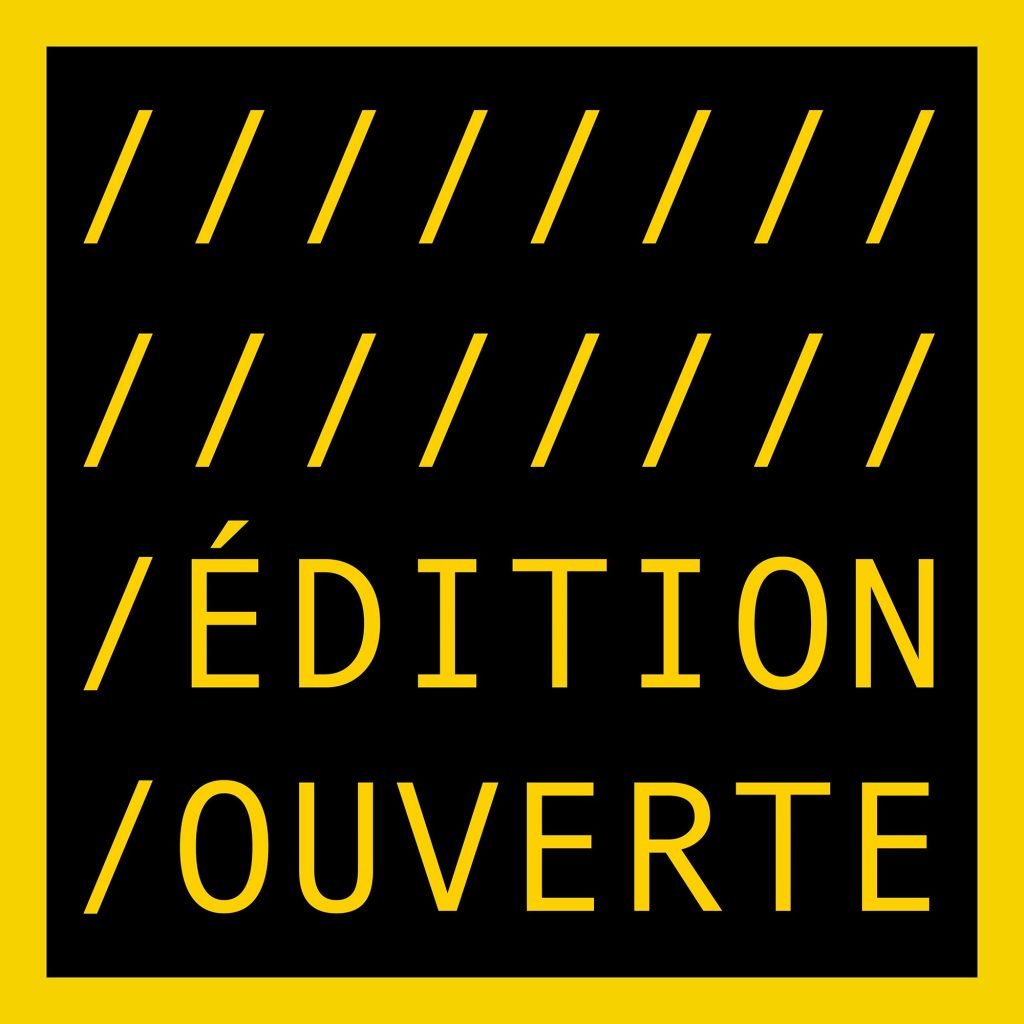
Kevin Abosch, Édition Ouverte. Photo: @kevinabosch on Twitter.
- Kevin Abosch‘s “Open Editions” mark a welcome approach for digital art aficionados seeking a more democratic collecting method during a wintry market. Launched in February and drawing from the aesthetic of his earlier “COMMENT-OUT” series in 2021, Abosch’s open editions swiftly became an online sensation, minting over 5,000 NFTs in a brief period.
- At Bitforms Gallery, Casey Reas’s latest exhibition, “It Doesn’t Exist (In Any Other Form),” delves into conceptual software painting, utilizing simulation and computer graphics. As an early artist integrating computational techniques, Reas co-established Processing in 2001. This showcase serves as a definitive tribute to Reas’s career, featuring pivotal works. Reas also collaborated with digital-art platform Gemma, offering an open-edition video of the exhibition’s focal piece and teasing a forthcoming long-form generative piece with fx(hash).
- Speaking of FX Hash… 2024 saw the launch of FX Hash0, both a generative art platform and a marketplace that lives as an open ecosystem. The platform was created by artist ciphrd in 2021, who has described the philosophy of fxhash as “no curation, open to everyone.” The Tezos-based platform has grown a network of diverse and loyal users. Now with its 2.0 upgrade, fxhash enables integrating Ethereum and more functionalities. The platform invited multiple artists and partners to drop new projects in the month of December, including drops from the rising Japanese artist takawo (with ARTXCODE) and qubibi, Dakar-based artist and curator Linda Dounia (with ARTXCODE), Mario Klingemann (Quasimondo) (with HEK – Haus der elektronischen Künste, a museum in Basel that boasts a DAO as part of its Web3 strategy), Taiwan-based artist SamuelYAN (with Volume DAO), Geoff Davis (with Expanded.Art), ciphrd & znah, and many more.
- Operator’s “Human Unreadable” project, launched on Artblocks this year, secured a Lumen Prize, an art-and-technology award. This three-act generative artwork merges choreography, code, blockchain, generative art, and cryptography, culminating in a live performance. This collection focuses on the body, inviting chaos and vulnerability, and revealing transparent layers that illuminate human experience across its phases.
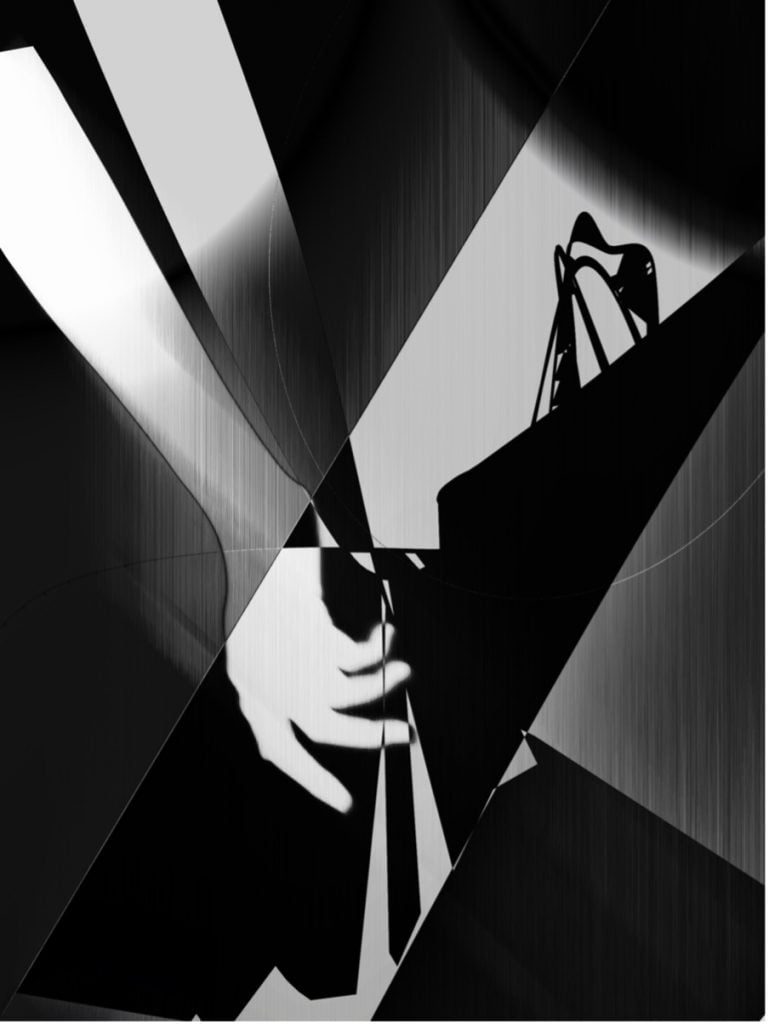
Operator, Human Unreadable #16 (2023). Courtesy of the artist.
- In 2023, collectors thefunnyguys and Zack Taylor unveiled Le Random, a new venture, dedicated to on-chain generative art. Beyond expanding its collection, Le Random curates a generative art database, producing editorial content that fosters discussions on generative art, and conducts interviews with artists working in the field.
- Trevor Paglen‘s first Web3 project, PRELUDES at Pace Verso, is part of the interactive artwork “CYCLOPS.” It plunges into 1960s C.I.A. mind control experiments and enigmatic historical events. The project offers interactive NFTs paired with visual scores, inspired by music pioneers like John Cage, along with composers Haydn, Brahms, and Messiaen, known for developing systems for encoding messages into their music. Paglen utilizes blockchain tech’s particularities to encode secrets within his NFTs, teaching cryptography fundamentals and probing political history along the way.
- Maya Man approaches the computer screen as a canvas for intimacy and performance, translating our offline experiences into on-screen content. Through algorithmic remixing and collaging, she offers commentary on internet culture within her websites, generative systems, and installations. One of her ongoing projects, Glance Back, takes the form of a daily photo diary Chrome extension, capturing the moments shared between users and their computers. In her recent exhibition at Verse Works, “I’m Feeling Lucky,” she delves into the contemporary world of astrology, creating a nostalgic echo of the past with a reference to Google’s “I’m Feeling Lucky” button, which made its debut in 1998.
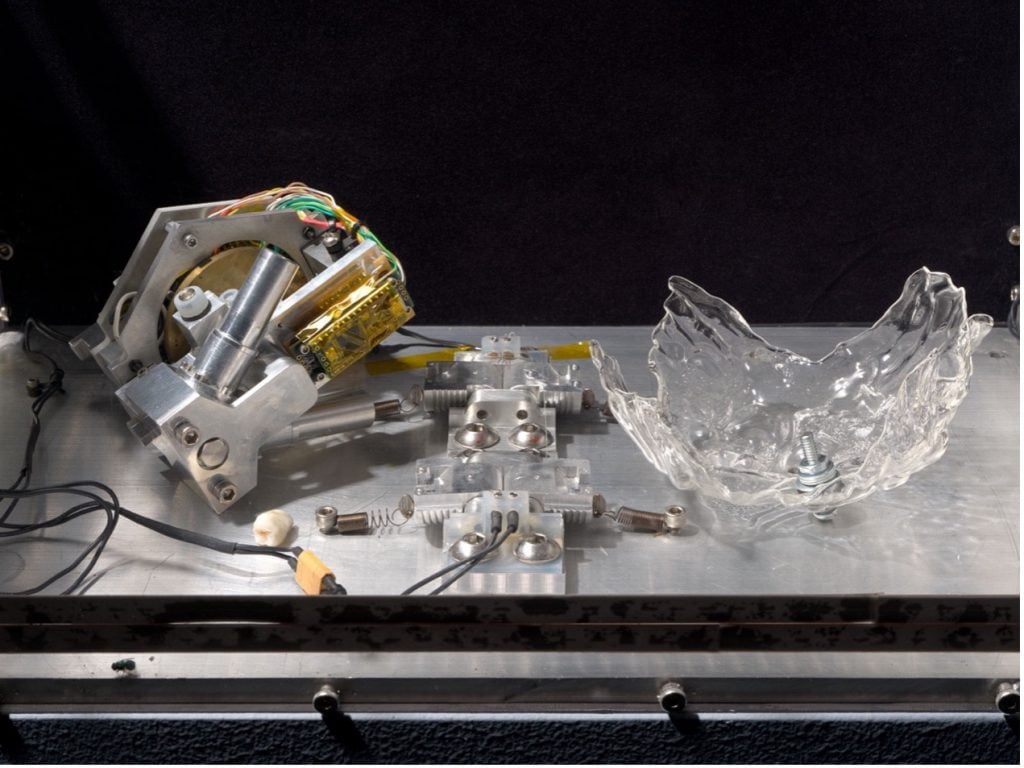
Installation view of Xin Liu, “Seedlings and Offsprings” at Pioneer Works. Courtesy of Pioneer Works. Photo by Dan Bradica.
- At Pioneer Works, Liu Xin’s “Seedlings and Offsprings” showcases recent and ongoing projects, including sculptures, videos, VR, and an outdoor installation. Exploring themes like space travel, vitality, mutation, and immortality, Xin delves into humanity’s drive to sustain its existence. New mixed-media sculptures, inspired by cryonics and egg freezing, reflect on on the disruption of natural life cycles. These sculptures use a cooling mechanism, creating frost layers and referencing Antarctic subglacial lakes and icy oceans on moons orbiting Jupiter and Saturn, where scientists seek traces of ancient life.
- “La Potière Jalouse: Rite of the Handmade” is a work by Helena Sarin. Known as her Twitter handle @NeuralBricolage, the artist distinguishes her practice by emphasizing the training of Generative Adversarial Networks (GANs) on her own hand-crafted datasets, ensuring unique and exclusive outputs that set her work apart. In the last two years, the artist has been working on ceramics with imagery generated using GANs. These pottery ceramics are designated as “future artifacts”—tangible tokens of a present that bows to the past.
- Anna Lucia’s “33 Million” project translates traditional sewing sampler patterns into algorithmic artworks, simultaneously engaging in both the creation and deconstruction of decorative aesthetics. Leveraging code’s randomness, each piece has a different unique look, but is produced through an automatic process. Lucia developed software to translate digital works into machine stitch patterns for embroidery on canvas, blurring boundaries between craft, art, and automation.
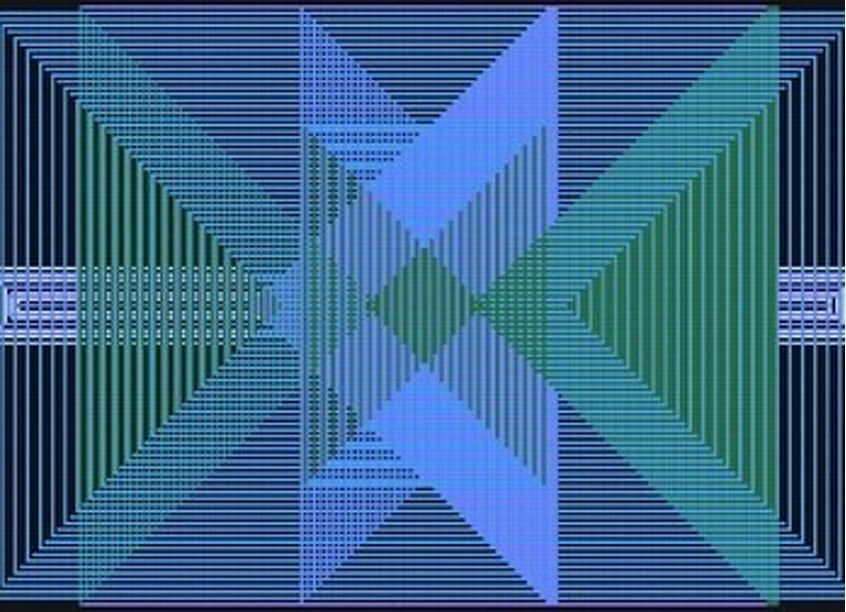
Herbert W. Franke, ZENTRUM, translated by Aaron Penne in 2023. Photo courtesy Foundation Herbert W. Franke.
- ZENTRUM, a significant creation from 1982 by Herbert W. Franke—the computer art pioneer, scientist, and science fiction writer—was developed using an Apple II computer and the Basic programming language. This “ZENTRUM” project features an ever-evolving abstract animation, composed of structural elements and random codes. Before Franke’s passing in 2022, he actively pursued integrating this code into the blockchain. To fulfill his vision, the Herbert W. Franke Foundation, comprising his estate and managed by his wife, Dr. Susanne Päch, collaborated with artist Aaron Penne. Together, they adapted and translated the original ZENTRUM code for the 2023 release, presented jointly with ART and PROOF. Thus, one of the hottest things in today’s generative art just might be looking to the past of generative art.
These are the things that inspired me last year. Of course, my perspective has admittedly leaned toward a Western-centric focus, and I’m certainly eager to be reminded of the great projects that I have overlooked, as there are many.
More generally, it was interest in A.I. technology that dominated discussions in 2023, a trend that is likely to continue in the new year. Yet I think of a recent illuminating piece penned by Sougwen Chung for the New York Times: “Where Does A.I End and We Begin?” She asks, “Can fear and hope coexist in the mind simultaneously? How do we comprehend the potential risks, and anxieties of technological advancements all at once?”
Such queries echo within the the realm of digital art, whether on-chain, off, or some experimental combination of the two—a still vastly uncharted domain, in both art history and in the market. In 2024, we should keep asking the question: Where does technology end and art begin?
